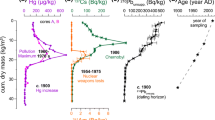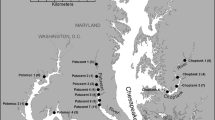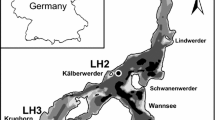Abstract
We determined phosphate uptake by calcareous sediments at two locations within a shallow lagoon in Bermuda that varied in trophic status, with one site being mesotrophic and the other being more eutrophic. Phosphate adsorption over a six hour period was significantly faster in sediments from the mesotrophic site. Uptake at both sites was significantly less than that reported for a similar experiment on calcareous sediments in an oligotrophic lagoon in the Bahamas. The difference in phosphorus adsorption between our sites did not appear to be related to sediment characteristics often cited as important, such as differences in surface area (as inferred from grain size distributions), total organic matter content, or iron content. However, the sediment total phosphorus contents were inversely related to phosphorus uptake at our sites in Bermuda, and at the previously studied Bahamas site.
We hypothesize that phosphate uptake in these calcareous sediments is a multi-step process, as previously described for fluvial sediments or pure calcium carbonate solids, with rapid initial surface chemisorption followed by a slower incorporation into the carbonate solid-phase matrix. Accordingly, sediments already richer in solid phase phosphorus take up additional phosphate more slowly since the slower incorporation of surface-adsorbed phosphate into the carbonate matrix limits the rate of renewal of surface-reactive adsorption sites.
Although carbonate sediments are a sink for phosphate, and thereby reduce the availability of phosphorus for benthic macrophytes and phytoplankton in the shallow overlying water, phosphate uptake by these sediments appears to decrease along a gradient from oligotrophic to eutrophic sites. If our result is general, it implies a positive feedback in phosphorus availability, with a proportionately greater percentage of phosphorus loading being biologically available longer as phosphorus loading increases. This pattern is supported by the significantly higher tissue phosphorus content of the seagrass,Thalassia testudinum, collected from the eutrophic inner bay site. Over time, this effect may tend to cause a shift from phosphorus to nitrogen limitation in some calcareous marine environments.
Similar content being viewed by others
References
Barrow NJ (1983) A mechanistic model for describing the sorption and desorption of phosphate by soil. J. Soil Sci. 34: 733–750
Berner RA (1974) Kinetic models for the early diagenesis of nitrogen, sulfur, phosphorus, and silicon in anoxic marine sediments. In: Goldberg ED (Ed), The Sea. Ideas and Observations of Progress in the Study of the Seas, vol. 5. John Wiley & Sons, New York
Berner RA (1982) Burial of organic carbon and pyrite sulfur in the modern ocean: Its geochemical and environmental significance. Am. J. Sci. 282: 451–473
Berner RA & Morse JW (1974) Dissolution kinetics of calcium carbonate in seawater: IV. Theory of calcite dissolution. Am. J. Sci. 274: 108–134
Billen G, Lancelot C & Meybeck M (1991) N, P, and Si retention along the aquatic continuum from land to ocean. In: Mantoura RFC, Martin JM & Wollast R. (Eds), Ocean Margin Processes in Global Change. Wiley & Sons, Chichester
Caffrey JM & Kemp Wm (1990) Nitrogen cycling in sediments with submersed macrophytes: Microbial transformations and inorganic pools associated with estuarine populations ofPotamogeton perfoliatus andZostera marina. Mar. Ecol. Prog. Ser. 66: 147–160
Caffrey JM & Kemp WM (1992) Influence of the submersed plant,Potamogeton perfoliatus, on nitrogen cycling in estuarine sediments. Limnol. Oceanogr. 37: 1483–1495
Capone DG, Dunham SE, Horrigan SG & Duguay LE (1992) Microbial nitrogen transformations in unconsolidated coral reef sediments. Mar. Ecol. Prog. Ser. 80: 75–88
Carter PW (1978) Adsorption of amino-acid containing organic mater associated with carbonate and non-carbonate sediments. Geochim. Cosmochim. Acta 42: 1239–1242
Carter PW & Mitterer RM (1978) Amino acid composition of organic matter associated with carbonate and non-carbonate sediments. Geochim. Cosmochim. Acta 42: 1231–1238
deKanel J & Morse JW (1978) The chemistry of orthophosphate uptake from seawater on to calcite and aragonite. Geochim. Cosmochim. Acta 42: 1335–1340
Duarte CM (1990) Seagrass nutrient content. Mar. Ecol. Prog. Ser. 67: 201–207
Erftemeijer PLA & Middelburg JJ (1993) Sediment-nutrient interactions in tropical seagrass beds: a comparison between a terrigenous and a carbonate sedimentary environment in South Sulawesi (Indonesia). Mar. Ecol. Prog. Ser. 102: 107–198
Fourqurean JW, Zieman JC & Powell GVN (1992a) Relationships between pore water nutrients and seagrasses in a subtropical carbonate environment. Mar. Biol. 114: 57–65
Fourqurean JW, Zieman JC & Powell GVN (1992b) Phosphorus limitation of primary production in Florida Bay: Evidence from C:N:P ratios of the dominant seagrassThalassia testudinum. Limnol. Oceanogr. 37: 162–171
Froelich PN (1988) Kinetic control of dissolved phosphate in natural rivers and estuaries: a primer on the phosphate buffer mechanism. Limnol. Oceanogr. 33: 649–668
Gaudette, HE & Lyons WB (1980) Phosphate geochemistry in nearshore carbonate sediments: A suggestion of apatite formation. SEPM Spec. Publ. #29: 215–225
Hamad ME, Rimmer DL & Syers JK (1992) Effect of iron oxide on phosphate sorption by calcite and calcareous soils. J. Soil Sci. 43: 273–281
Howarth RW (1988) Nutrient limitation of net primary production in marine ecosystems. Ann. Rev. of Ecol. System. 19: 89–110
Howarth RW, Marino R, Lane J, & Cole JJ (1988) Nitrogen fixation in freshwater, estuarine, and marine ecosystems. I. Rates and importance. Limnol. Oceanogr. 33: 669–687
Howarth RW, Jensen H, Marino R & Postma H (in press) Transport and processing of phosphorus in estuaries and oceans. In: Tiessen H (Ed) Phosphorus Cycling in Terrestrial and Aquatic Ecosystems (SCOPE). Wiley & Sons, Chichester
Kitano Y, Okumura M & Idogak M (1978) Uptake of phosphate ions by calcium carbonate. Geochem. Jour. 12: 29–37
Koroleff F (1983) Determination of nutrients. In: Grasshoff K, Ehrhardt M & Kremling K (Eds) Methods of Seawater Analysis, Second Edition. Verlag Chemie, Weinheim
Krom MD & Berner RA (1980) Adsorption of phosphate in anoxic marine sediments. Limnol. Oceanogr. 25: 327–338
Krom MD & Berner RA (1981) The diagenesis of phosphorus in a nearshore marine sediment. Geochim. Cosmochim. Acta 45: 207–216
Lahann RW & Campbell RC (1980) Adsorption of palmitic acid on calcite. Geochim. Cosmochim. Acta 44: 629–634
Lapointe BE, Littler MM & Littler DS (1987) A comparison of nutrient-limited productivity in macroalgae from a Caribbean barrier reef and from a mangrove ecosystem. Aquat. Bot. 28: 243–255
Lapointe BE & O'Connell JD (1989) Nutrient-enhanced growth ofCladophora prolifera in Harrington Sound, Bermuda: Eutrophication of a confined, phosphorus-limited marine ecosystem. Est. Coast. Shelf Sci. 28: 347–360
Lapointe BE, O'Connell JD & Garrett GS (1990) Nutrient couplings between on-site sewage disposal systems, groundwaters, and nearshore surface waters of the Florida Keys. Biogeochemistry 10: 289–307
Littler MM, Littler DS & Lapointe BE (1988) A comparison of nutrient- and light-limited photosynthesis in psammophytic versus epilithic forms ofHalimeda (Caulerpales, Halimedaceae) from the Bahamas. Coral Reefs 6: 219–225
McDowell WH, Cole JJ & Driscoll CT (1987) Simplified version of the ampoule-persulfate method for determination of dissolved organic carbon. Can. Jour. Fish. Aquat. Sci. 44: 214–218
McGlathery KJ (1992a) Nutrient and grazing influences on seagrass community dynamics. Ph.D. Dissertation, Cornell University, Ithaca NY, U.S.A
McGlathery KJ (1992b) Physiological controls on the distribution of the macroalgaSpyridea hypnoides: Patterns along a eutrophication gradient in Bermuda. Mar. Ecol. Prog. Ser. 87: 173–182
McGlathery KJ, Howarth RW & Marino R (1992) Nutrient limitation of the rhizoid macroalga,Penicillus capitatus, in Bermuda. Estuaries 15: 18–25
Mills GL & JG Quinn (1979) Determination of organic carbon in marine sediments by persulfate oxidation. Chemical Geology 25: 155–162
Morse JW (1986) The surface chemistry of calcium carbonate minerals in natural waters: an overview. Mar. Chem. 20: 91–112
Morse JW & Mackenzie FT (1990) Geochemistry of Sedimentary Carbonates. Elsevier, Amsterdam
Morse JW, Zullig JJ, Bernstein LD, Millero FJ, Milne P, Mucci A & Choppin GR (1985) Chemistry of calcium carbonate-rich shallow water sediments in the Bahamas. Am. J. Sci. 285: 147–185
Morse JW, Zullig JJ, Iverson RL, Choppin GR, Mucci A & Millero FJ (1987) The influence of seagrass beds on carbonate sediments in the Bahamas. Mar. Chem. 22: 71–83
O'Neil JM & Capone DG (1989) Nitrogenase activity in tropical carbonate marine sediments. Mar. Ecol. Prog. Ser. 56: 145–156
Patriquin D (1972) The origin of nitrogen and phosphorus for growth of the marine angiosperm,Thalassia testudinum. Mar. Biol. 15: 35–46
Powell GVN, Kenworthy WJ & Fourqurean JW (1989) Experimental evidence for nutrient limitation of seagrass growth in a tropical estuary with restricted circulation. Bull. Mar. Sci. 44: 324–340
Ruttenberg KC (1992) Development of a sequential extraction method for different forms of phosphorus in marine sediments. Limnol. Oceanogr. 37: 1460–1483
Seitzinger SP (1988) Denitrification in freshwater and coastal marine ecosystems: Ecological and geochemical significance. Limnol. Oceanogr. 33: 702–724
Sherwood BA, Sager SL & Holland HD (1987) Phosphorus in foraminiferal sediments from the North Atlantic Ridge cores and in pure limestones. Geochim. Cosmochim. Acta 51: 1861–1866
Short FT, Davis MW, Gibson RA & Zimmerman CF (1985) Evidence for phosphorus limitation in carbonate sediments of the seagrassSyringodium filiforme. Est. Coast. Shelf Sci. 20: 419–430
Short FT, Dennison WC & Capone DC (1990) Phosphorus-limited growth of the tropical seagrassSyringodium filiforme in carbonate sediments. Mar. Ecol. Prog. Ser. 62: 169–174
Simmons JAK, Jickells T, Knap A & Lyons WB (1985) Nutrient concentrations in groundwaters from Bermuda: Anthropogenic effects. In: Caldwell DE & Brierly JA (Eds) Planetary Ecology (pp 383–398) Van Nostrand Reinhold Company, Inc. NY
Smith SV (1984) Phosphorus vs. nitrogen limitation in the marine environment. Limnol. Oceanogr. 29: 1149–1160
Smith SV & Atkinson MJ (1984) Phosphorus limitation of net production in confined aquatic ecosystems. Nature 207: 626–627
Stainton MP, Capel MJ & Armstrong FA (1974) The chemical analysis of freshwater. Misc. Spec. Publ. 25, Dept. of the Environment, Freshwater Institute, Research Development Directorate, Winnipeg
Stumm W (1992) Chemistry of the Solid-Water Interface. Wiley & Sons, Inc., New York
Stumm W & Leckie JO (1970) Phosphate exchange with sediments: Its role in the productivity of surface waters. In: Advances in Water Pollution Research, Vol. 2, III: 26/1–26/16. Permagon, Oxford
Suess E (1968) Calcium carbonate interaction with organic compounds. Ph.D. Dissertation, Lehigh University, Bethlehem, PA
Suess E (1970) Interaction of organic compounds with calcium carbonate-I. Association of phenomena and geochemical implications. Geochim. Cosmochim. Acta 34: 157–168
Suess E (1973) Interaction of organic compounds with calcium carbonate-II. Organo-carbonate association in Recent sediments. Geochim. Cosmochim. Acta 37: 2435–2447
Vieillard P & Tardy Y (1984) Thermochemical Properties of phosphates. In: Nriagu JO & Moore PB (Eds) Phosphate Minerals (pp 171–198), Springer-Verlag, Berlin
Walter LM & Morse JW (1984) Reactive surface area of skeletal carbonates during dissolution: Effect of grain size. J. Sed. Petrol. 54: 1081–1090
Williams SL (1984) Uptake of sediment ammonium and translocation in a marine green macroalgaCaulerpa cupressoides. Limnol. Oceanogr. 29: 374–379
Zimmerman CF, Montgomery JR & Carlson PR (1985) Variability of dissolved reactive phosphate flux rates in nearshore estuarine sediments: Effects of groundwater flow. Estuaries 8: 228–236
Author information
Authors and Affiliations
Rights and permissions
About this article
Cite this article
McGlathery, K.J., Marino, R. & Howarth, R.W. Variable rates of phosphate uptake by shallow marine carbonate sediments: Mechanisms and ecological significance. Biogeochemistry 25, 127–146 (1994). https://doi.org/10.1007/BF00000882
Received:
Accepted:
Issue Date:
DOI: https://doi.org/10.1007/BF00000882




